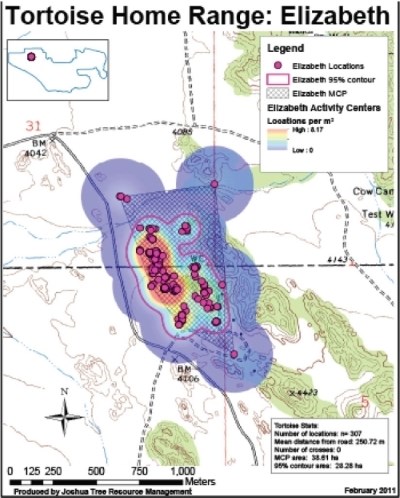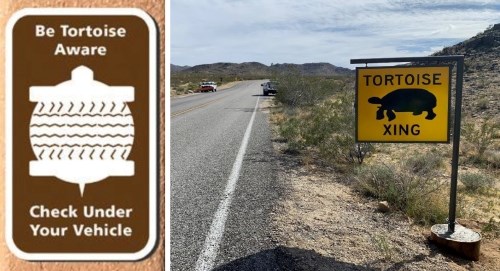Last updated: May 25, 2023
Article
Desert Tortoise Telemetry and Conservation

NPS Photos
A desert tortoise lumbers across the sand like a small boulder come to life. Look closely and you may spot an extra knob on the rough, dark brown shell. It’s a radio transmitter, attached temporarily by park biologists. The small electronic device emits a signal that the biologists can detect, using a directional antenna and a VHF radio receiver.
With this technology, park biologists can locate an individual tortoise again and again. They can learn whether it’s active or at rest, where it goes, how its movements change as water or food become more or less abundant, and the size of its home range (how far it typically travels).
Why Track Tortoises in the Park?
Biologists in Joshua Tree National Park have been collaborating with the U.S. Fish and Wildlife Service to monitor Mojave desert tortoises (Gopherus agassizii) with radiotelemetry since 2003—one of the longest-running tortoise monitoring programs in the nation. The initial goal of the program was to evaluate whether adding curbs to some roads (to protect sensitive habitat from off-road driving) would interfere with tortoise movements. Park biologists found that tortoises could scale curbing easily with only a slight design change. Since then, the telemetry program has continued to study how tortoises behave around roads.
Tortoises in Trouble
Studying tortoises around roads is important because the Mojave population of the desert tortoise (tortoises found north and west of the Colorado River) seems to be crashing—even though the species has received special protections as a threatened species for more than three decades. Thirty years ago, biologists counted as many as 30 tortoises per km2 within the park, but today they find slightly more than 3 per km2 on average—barely enough to prevent the population from dwindling to extinction.
Many factors contribute to tortoise population declines, but road mortality is one. Obviously, tortoises move slowly; cars go fast. Outside of protected areas like Joshua Tree National Park, many tracts of desert habitat are crisscrossed by miles of new roads (for housing developments or energy installations) or off-road vehicle trails. Tortoises can be attracted to the water that pools on roads after a rainstorm, and to the tender wildflowers that sprout on berms watered by road runoff. One study estimated that, in any given year, at least one tortoise is killed for every 3.2 km of heavily traveled road.

(NPS graphic)
What Radiotelemetry Reveals
Since the park's radiotelemetry program began, biologists have studied 29 tortoises; currently, 15 are being monitored. Biologists use telemetry to locate each animal at least twice a month between March and October (when water and the tortoises’ preferred food, wildflowers, are most abundant). The rest of the year, biologists check on the tortoises once a month. If a tortoise is on the move, a biologist will follow, to record what it does if it encounters a road.
Telemetry data show that tortoises with home ranges that include busy, paved roads rarely try to cross them (for example, see the Feb 2011 range map for "Elizabeth," at right. Her home range abuts a paved road, but she stayed north and east of that road). Tortoises with home ranges that include lightly traveled dirt roads cross these roads frequently. Tortoises living near paved roads with moderate traffic cross at an intermediate rate. But the two individuals in the study that crossed moderate-traffic roads most frequently were ultimately killed in collisions with vehicles.
Managing Park Roads to Protect Tortoises
Joshua Tree National Park has comparatively few roads, and cars don’t go very fast (the top speed is 45 mph). But the number of visitors to the park has doubled (from 1.4 million to 3 million) in the past decade, and the number of tortoises found dead on park roads has increased--notably in 2017 and 2019, when “superblooms” of desert wildflowers drew crowds to the park.
Since then, the park has taken several management actions recommended by the Desert Tortoise Management Oversight Group of the U.S. Fish and Wildlife Service to help reduce tortoise road deaths. “Tortoise Crossing” signs are now visible at road locations where tortoises have been killed.

(NPS / Kristen Lalumiere)
Educational signs have also been installed at each of the park’s 500 campsites, reminding visitors to check for tortoises under their vehicles before driving away. (Tortoises will seek out any shade on a hot day).
Other outreach to raise awareness about the challenges to tortoises includes ranger talks and campfire talks, an annual “Tortoise Week” celebration, and social media campaigns. Park staff also restore habitat that has been damaged by illegal off-highway vehicle activity and install barriers to prevent new damage from occurring. One other key management action is controlling the number of common ravens, which prey on tortoise hatchlings. The process involves locating active raven nests in areas where tortoise populations are the largest, then coating eggs with vegetable oil, which prevents them from hatching.
